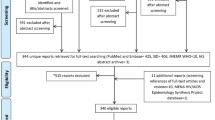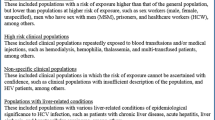Abstract
Introduction
Reuse of contaminated syringes, high frequency of injections, tattooing and skin piercing have repeatedly been shown to be important and independent risk factors for the transmission of hepatitis B (HBV) and C (HCV) infections in South Asian countries. Estimation of population-attributable risks indicates the potential for hepatitis prevention if the exposure to certain modifiable factors can be eliminated.
Methods
We estimated the population-attributable risks of various risk factors for transmission of HBV and HCV using data from a large, nationally representative survey conducted in 2007 across Pakistan, a country known to have a high prevalence of chronic viral hepatitis. Odds ratio estimates and observed prevalence of the risk factors were used for calculating PAR estimates. We also performed a systematic review of published studies that identify the prevalence of similar modifiable risk factors for HBV and HCV from other South Asian countries in order to define an overall prevention strategy for the region.
Results
For HBV, a high frequency (>10) of therapeutic injections in the past 1 year had an attributable risk of 3.5 % (95 % CI 2.9–3.9), reuse of syringes had a 2.7 % risk (95 % CI 2.2–3.1), the practice of being shaved by a barber 2.1 % (95 % CI 1.7–2.6), sharing of smoking utensils 4.4 % (95 % CI 3.8–4.9) and ear/nose piercing 1.4 % (95 % CI 1.2–1.7).
Population-attributable risks for HCV were as follows: high frequency of therapeutic injections in the past 1 year 11.3 % (95 % CI 10.5–11.7), reuse of syringes 6.2 % (95 % CI 6.1–6.9), practice of being shaved by a barber shop 7.9 % (95 % CI 7.1–8.2), sharing of smoking utensils 8.1 % (95 % CI 6.9–8.5), practice of ear/nose piercing among females 5.9 % (95 % CI 5.2–6.1) and tattooing 5 % (95 % CI 4.3–5.6). A systematic review showed that other South Asian countries share a number of common risk factors for the transmission of viral hepatitis.
Conclusion
A substantial number of HBV and HCV infections in Pakistan and other South Asian countries can be prevented by key interventions targeted toward a few selected and modifiable risk factors. Hence, policies specifically targeted at key risk factors for HBV and HCV such as safe and rational use of injections prescribed by trained health-care providers are urgently needed for countries like Pakistan.

Similar content being viewed by others
References
Te HS, Jensen DM. Epidemiology of hepatitis B and C viruses: a global overview. Clin Liver Dis 2010;14(1):1–21
Dore GJ, Freeman AJ, Law M, Kaldor JM. Is severe liver disease a common outcome for people with chronic hepatitis C? J Gastroenterol Hepatol 2002;17(4):423–430
Perz JF, Armstrong GL, Farrington LA, Hutin YJF, Bell BP. The contributions of hepatitis B virus and hepatitis C virus infections to cirrhosis and primary liver cancer worldwide. J Hepatol 2006;45(4):529–538
Lavanchy D. Hepatitis B virus epidemiology, disease burden, treatment, and current and emerging prevention and control measures. J Viral Hepat 2004;11(2):97–107
Hall A. At last a global response to viral hepatitis. Bull World Health Organ 2010;88:801–802
Ali SA, Donahue RMJ, Qureshi H, Vermund SH. Hepatitis B and hepatitis C in Pakistan: prevalence and risk factors. Int J Infect Dis 2009;13(1):9–19
Global Burden of Disease Working Group. Global burden of disease (GBD) for hepatitis C. J Clin Pharmacol 2004;44(1):20–29
Nelson PK, Mathers BM, Cowie B, Hagan H, Des Jarlais D, Horyniak D, et al. Global epidemiology of hepatitis B and hepatitis C in people who inject drugs: results of systematic reviews. The Lancet 2011;378:571–583
Ahmed W, Arif A, Alam SE, Qureshi H. Changing trend of viral hepatitis—“A twenty one year report from Pakistan Medical Research Council Research Centre, Jinnah Postgraduate Medical Centre, Karachi”. J Pak Med Assoc 2010;61:86–89
Qureshi H, Bile KM, Jooma R, Alam SE, Afridi HUR. Prevalence of hepatitis B and C viral infections in Pakistan: findings of a national survey appealing for effective prevention and control measures. East Mediterr Health J 2010;16:S15–S23
Lavanchy D. The global burden of hepatitis C. Liver Int 2009;29:74–81
Sievert W, Altraif I, Razavi HA, Abdo A, Ahmed EA, Al Omair A, et al. A systematic review of hepatitis C virus epidemiology in Asia, Australia and Egypt. Liver Int 2011;31:61–80
Janjua NZ, Hamza HB, Islam M, Tirmizi SFA, Siddiqui A, Jafri W, et al. Health care risk factors among women and personal behaviours among men explain the high prevalence of hepatitis C virus infection in Karachi, Pakistan. J Viral Hepat 2010;17(5):317–326
Fleiss JL. Inference about population attributable risk from cross-sectional studies. Am J Epidemiol 1979;110(2):103
Organization WH. Resolution A63/15: Viral hepatitis. 63rd World Health Assembly. 2010
Strathdee SA, Zafar T, Brahmbhatt H, Baksh A. Rise in needle sharing among injection drug users in Pakistan during the Afghanistan war. Drug Alcohol Depend 2003;71(1):17–24.
Kuo I. High HCV seroprevalence and HIV drug use risk behaviors among injection drug users in Pakistan. Harm Reduct J 2006;3(1):26
Kane A, Lloyd J, Zaffran M, Simonsen L, Kane M. Transmission of hepatitis B, hepatitis C and human immunodeficiency viruses through unsafe injections in the developing world: model-based regional estimates. Bull World Health Organ 1999;77(10):801–807
Chowdhury AK, Roy T, Faroque AB, Bachar SC, Asaduzzaman M, Nasrin N, et al. A comprehensive situation assessment of injection practices in primary health care hospitals in Bangladesh. BMC Public Health 2011;11(1):779
Saravanan S, Velu V, Kumarasamy N, Shankar EM, Nandakumar S, Murugavel KG, et al. The prevalence of hepatitis B virus and hepatitis C virus infection among patients with chronic liver disease in South India. Int J Infect Dis 2008;12(5):513–518
Chowdhury A, Santra A, Chaudhuri S, Dhali GK, Chaudhuri S, Maity SG, et al. Hepatitis C virus infection in the general population: a community-based study in West Bengal, India. Hepatology 2003;37(4):802–809
Sood A, Vandana M, Neena S, Harpreet K, Malhotra V, Awasthi G. Chronic hepatitis C in northern India. The pathological and clinical spectrum. JAPI 2004;52:380–384
Idrees M, Riazuddin S. Frequency distribution of hepatitis C virus genotypes in different geographical regions of Pakistan and their possible routes of transmission. BMC Infect Dis 2008;8(1):69
Luby SP, Qamruddin K, Shah AA, Omair A, Pahsa O, Khan AJ, et al. The relationship between therapeutic injections and high prevalence of hepatitis C infection in Hafizabad, Pakistan. Epidemiol Infect 1997:349–356
Janjua NZ, Akhtar S, Hutin YJF. Injection use in two districts of Pakistan: implications for disease prevention. Int J Qual Health Care 2005;17(5):401
Lock G, Dirscherl M, Obermeier F, Gelbmann CM, Hellerbrand C, Knöll A, et al. Hepatitis C—contamination of toothbrushes: myth or reality? J Viral Hepat 2006;13(9):571–573
Hayajneh WA, Masaadeh HA, Hayajneh YA. A case–control study of risk factors for hepatitis B virus infection in North Jordan. J Med Virol 2010;82(2):220–223
Atmore C, Milne A, Pearce N. Modes of hepatitis B virus transmission in New Zealand. N Z Med J 1989;102(869):277
Goh KT, Ding JL, Monteiro EH, Oon CJ. Hepatitis B infection in households of acute cases. J Epidemiol Commun Health 1985;39(2):123
Bari A, Akhtar S, Rahbar MH, Luby SP. Risk factors for hepatitis C virus infection in male adults in Rawalpindi–Islamabad, Pakistan. Trop Med Int Health 2001;6(9):732–738
Khaliq AA. Barber shaving and blood-borne disease transmission in developing countries. S Afr Med J 2008;95(2):94
Janjua NZ, Nizamy MAM. Knowledge and practices of barbers about hepatitis B and C transmission in Rawalpindi and Islamabad. J Pak Med Assoc 2004;54(3):116–118
Jafari S, Copes R, Baharlou S, Etminan M, Buxton J. Tattooing and the risk of transmission of hepatitis C: a systematic review and meta-analysis. Int J Infect Dis 2010;14(11):e928–e940
Ghias M, Pervaiz MK. Identification of epidemiological risk factors for hepatitis c in Punjab, Pakistan. J Ayub Med Coll Abbottabad 2009;21(2):156–161
Usman HR, Akhtar S, Rahbar MH, Hamid S, Moattar T, Luby SP. Injections in health care settings: a risk factor for acute hepatitis B virus infection in Karachi, Pakistan. Population 2003;11:12
Masood Z, Jawaid M, Khan RA, Rehman SU. Screening for hepatitis B & C: a routine pre-operative investigation. Pak J Med Sci 2005;21(4):455
Chowdhury A, Santra A, Chakravorty R, Banerji A, Pal S, Dhali GK, et al. Community-based epidemiology of hepatitis B virus infection in West Bengal, India: prevalence of hepatitis B e antigen-negative infection and associated viral variants. J Gastroenterol Hepatol 2005;20(11):1712–1720
Jagannathan L, Chaturvedi M, Mudaliar S, Kamaladoss T, Rice M, Murphy EL. Risk factors for chronic hepatitis B virus infection among blood donors in Bangalore, India. Transfus Med 2010;20(6):414–420
Kumar A, Sharma KA, Gupta RK, Kar P, Chakravarti A. Prevalence & risk factors for hepatitis C virus among pregnant women. Indian J Med Res 2007;126(3):211
Thakral B, Marwaha N, Chawla YK, Saluja K, Sharma A, Sharma RR, et al. Prevalence & significance of hepatitis C virus (HCV) seropositivity in blood donors. Indian J Med Res 2006;124(4):431
Ashraf H, Alam N, Rothermundt C, Brooks A, Bardhan P, Hossain L, et al. Prevalence and risk factors of hepatitis B and C virus infections in an impoverished urban community in Dhaka, Bangladesh. BMC Infect Dis 2010;10(1):208
Gibney L, Saquib N, Metzger J, Choudhury P, Siddiqui MA, Hassan MS. Human immunodeficiency virus, hepatitis B, C and D in Bangladesh’s trucking industry: prevalence and risk factors. Int J Epidemiol 2001;30(4):878–884
Mahtab M, Rahman S, Karim MF, Khan M, Foster G, Solaiman S, et al. Epidemiology of hepatitis B virus in Bangladeshi general population. Hepatobiliary Pancreat Dis Int 2008;7(6):595–600
Shirin T, Ahmed T, Iqbal A, Islam M, Islam MN. Prevalence and risk factors of hepatitis B virus, hepatitis C virus, and human immunodeficiency virus infections among drug addicts in Bangladesh. J Health Popul Nutr 2011;18(3):145–150
Hajiani E, Hashemi J, Masjedizadeh R, Shayesteh AA, Idani E, Rajabi T. Seroepidemiology of hepatitis C and its risk factors in Khuzestan Province, south-west of Iran: a case–control study. World Journal Gastroenterol 2006;12(30):4884
Jahani MR, Motevalian SA, Mahmoodi M. Hepatitis B carriers in large vehicle drivers of Iran. Vaccine 2003;21(17–18):1948–1951
Merat S, Rezvan H, Nouraie M, Jamali A, Assari S, Abolghasemi H, et al. The prevalence of hepatitis B surface antigen and anti-hepatitis B core antibody in Iran: a population-based study. Arch Iran Med 2009;12(3):225–231
Zamani S, Ichikawa S, Nassirimanesh B, Vazirian M, Ichikawa K, Gouya MM, et al. Prevalence and correlates of hepatitis C virus infection among injecting drug users in Tehran. Int J Drug Policy 2007;18(5):359–363
Shahnaz Sali MD, Reza Bashtar MD, Seyed-Moayed Alavian MD. Risk factors in chronic hepatitis B infection: a case–control study. Hepat Mon 2005;5(4):109–115
Acknowledgements
We would like to acknowledge the efforts of Dr. Sadia Mahmud (PhD), Associate Professor of Biostatistics, Department of Community Health Sciences, Aga Khan University, for her help with the statistical analysis in the article.
Author information
Authors and Affiliations
Corresponding author
Electronic supplementary material
Below is the link to the electronic supplementary material.
Rights and permissions
About this article
Cite this article
Ahmed, B., Ali, T., Qureshi, H. et al. Population-attributable estimates for risk factors associated with hepatitis B and C: policy implications for Pakistan and other South Asian countries. Hepatol Int 7, 500–507 (2013). https://doi.org/10.1007/s12072-012-9417-9
Received:
Accepted:
Published:
Issue Date:
DOI: https://doi.org/10.1007/s12072-012-9417-9




